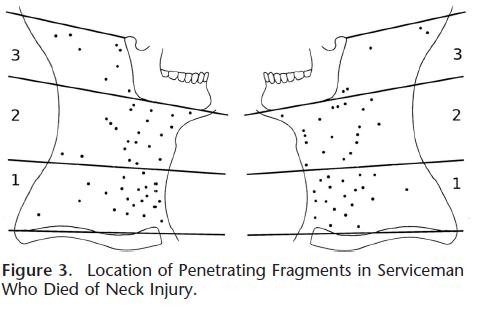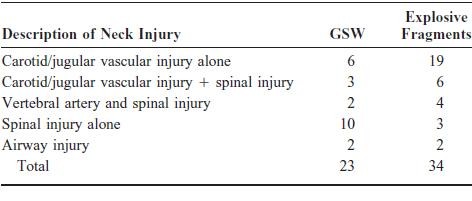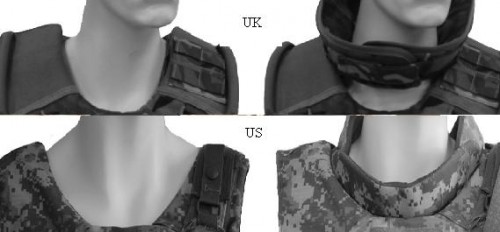13/04/2012
Les plaies du cou: Danger
Mortality and morbidity from combat neck injury
Breeze J. et all. J Trauma. 2012;72: 969–974.
-----------------------------------------------------------------------------------
BACKGROUND:
Neck injury represents 11% of battle injuries in UK forces in comparison with 2% to 5% in US forces. The aim of this study was to determine the causes of death and long-term morbidity from combat neck injury in an attempt to recommend new methods of protecting the neck.
METHOD:
Hospital and postmortem records for all UK servicemen sustaining battle injuries to the neck between January 1, 2006 and December 31, 2010 were analyzed.
RESULTS:
Neck wounds were found in 152 of 1,528 (10%) of battle injured service personnel. Seventy-nine percent of neck wounds were caused by explosions and were associated with a mortality rate of 41% compared with 78% from gunshot wounds (GSWs). Although current UK OSPREY neck collars can potentially protect zone I from explosive fragments, in the 58% in which the wearing of a neck collar was known, all service personnel chose not to wear the collar. The most common cause of death from explosive fragments was vascular injury (85%). Zone II was the most commonly affected area overall by explosive fragments and had the highest mortality but zone I was associated with the highest morbidity in survivors.
CONCLUSIONS:
Nape protectors, that cover zone III of the neck posteriorly, would only have potentially prevented 3% of injuries and therefore this study does not support their use. Current UK OSPREY neck collars potentially protect against the majority of explosive fragments to zones I and II and had these collars been worn potentially 16 deaths may have been prevented. Reasons for their lack of uptake by UK servicemen is therefore being evaluated. Surface wound mapping of penetrating explosive fragments in our series has been used to validate the area of coverage required for future designs of neck protection.
-----------------------------------------------------------------------------------
1. Des lésions essentiellement antérieures
2. Une atteinte surtout des zones 1 et 2
3. 28% des décédés sont porteurs de lésions cervicales en rapport direct avec le décès dans 73% des cas.
4. Des causes de décès différentes en fonction du type lésionnel
5. Un manque d' adhésion au port de la protection qui expliquerait cette fréquence, une histoire d'ergonomie ?
Du même auteur: Lire aussi




Les commentaires sont fermés.